Walking Down the “Prettie Street” of 17th-Century Ferryland, Newfoundland
Cathy MathiasMemorial University of Newfoundland
Résumé
Cet article examine des restes textiles, remontant au XVIIe siècle, découverts dans des latrines à Ferryland, à Terre-Neuve, sous deux angles : le type de tissu employé par les colons de Ferryland, prospère plantation du XVIIe siècle ; et ce que signifient ces fragments intentionnellement découpés. L’environnement anaérobique humide a permis une bonne conservation des textiles découverts, et l’analyse effectuée avec un équipement à la fine pointe de la technologie a révélé qu’une grande variété de textiles étaient en usage, variant selon la classification des « anciennes draperies » aux « nouvelles draperies ». Les analyses démontrent également qu’à Ferryland, au XVIIe siècle, les statuts sociaux étaient nettement différenciés, comme le montre la grande diversité des textiles, allant de la laine grossière à la laine fine, la soie, le satin de soie, la soie damassée et le velours. Les analyses des teintures ont révélé la présence de différentes matières tinctoriales produisant des couleurs allant du rouge au mauve, en passant par le jaune.Abstract
In this article textile remains dating to the 17th century that were uncovered in a privy at Ferryland, Newfoundland are discussed. Two issues are examined: the type of cloth used by the colonists at Ferryland, a prosperous 17th century plantation; and what the purposely cut fragments found in the privy represent. While the moist anaerobic environment allowed for good preservation of the excavated textiles, analysis using state of the art equipment revealed a variety of textiles were in use, ranging from the “Old Draperies” to the “New Draperies” classifications. Analysis also shows that 17th century Ferryland was comprised of low, middle and high status people as evidenced by the variety of textiles including coarse to fine wools, silk, silk satin, silk damask and velvet. Dye analysis revealed the presence of different dye materials that produced colours from reds to yellows to purple.1 In 1621 George Calvert (later the First Lord Baltimore) sent Captain Edward Wynne and a group of West Country and Welsh settlers to Ferryland, Newfoundland, Canada, to establish a permanent settlement based on the lucrative in-shore cod fishery (Fig.1). Lord Baltimore first visited his colony in the summer of 1627 and returned in 1628 with his family and an entourage of some forty people. Lord Baltimore moved on within the year, leaving the management of the growing colony in the hands of his overseer, Captain Wynne. Peter E. Pope (1998) notes, however, that Wynne was eventually ousted by Sir David Kirke who “expropriated Ferryland in 1638 under a patent for a Newfoundland Plantation, granted by Charles I to Kirke...” (6). Sir David died in 1654, but his widow and sons continued to operate the fishery plantations at Ferryland (5-6). In 1673, the Dutch attacked the colony; it recovered from the assault but after the French captured and burned the site in 1696, activity ceased until the early 1700s (Gaulton and Tuck 2003).
2 There is sufficient historical documentation to indicate that Kirke and his family profited from Newfoundland’s rich fishery. As James Deetz (1977) has noted, however, written records provide a window through which the past can be viewed, but that “[t]aken together, inventories and archaeological assemblages give a more detailed and complete picture than either could alone” (11), a statement that speaks to the importance of such sites as the one at Ferryland. Over the years, the excavated artifactual and architectural remains at Ferryland’s archaeological site have provided ample evidence to support historical accounts. Where historical documents indicate that Calvert’s colonists constructed a mansion house (Fig. 2), brewhouse, salt works, forge, hen house, kitchen, fishing stores and dwellings (Pope 1996: 1- 20), the excavated remains of many of these buildings are now supporting the written records and have produced a rich collection of 17th-century material culture. In this essay some of the textile remains found in a privy deposit provide information about the 17th-century English plantation that documents alone could not have revealed (Fig. 3). Specifically, textile fragments provide evidence that not only did the high fashion of Europe adorn the bodies and homes of the 17th-century colonists, but that indeed, Europe’s stylish costumes also served a secondary function in Ferryland.
Fig. 1 (right) Aerial view of Ferryland with archaeological site outlined and circled.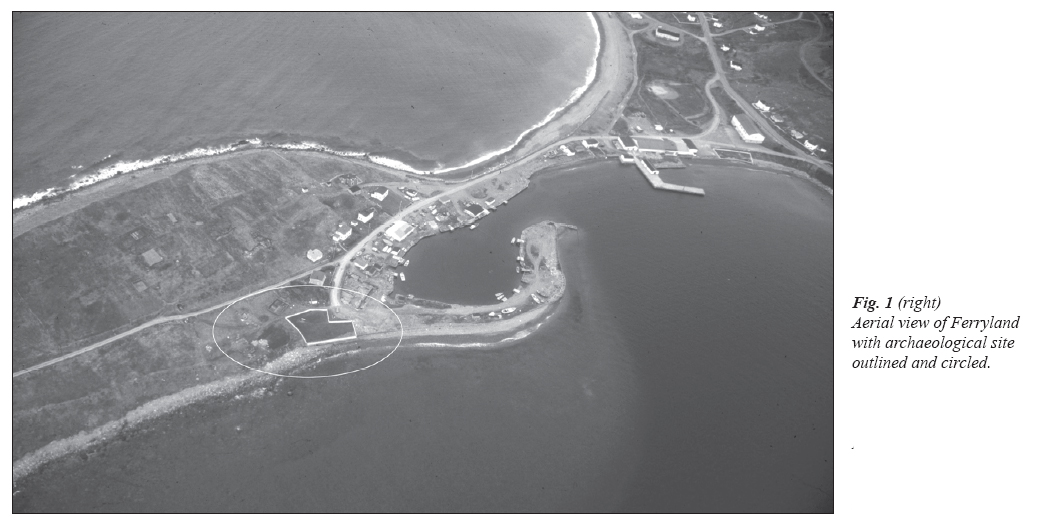
Display large image of Figure 1
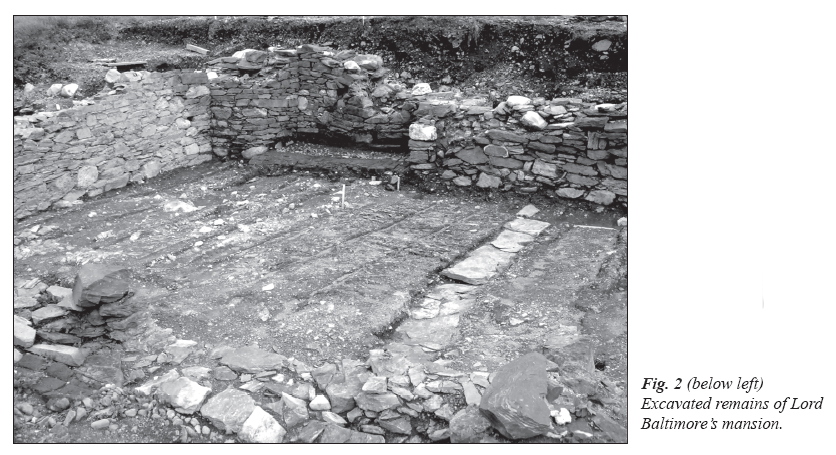
Display large image of Figure 2
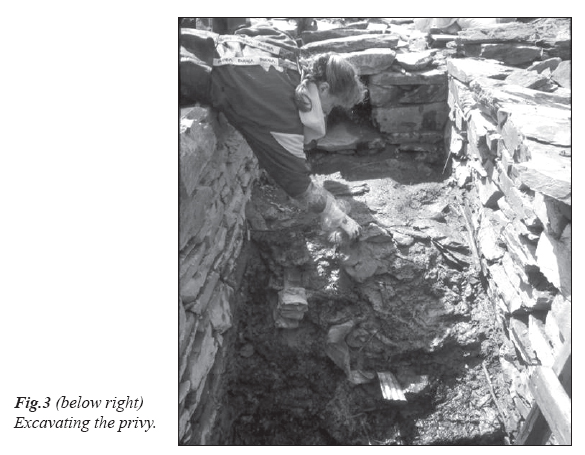
Display large image of Figure 3
3 As noted above, there are primarily two different phases of occupation and development at Ferryland. The earlier phase coincides with George Calvert’s control of the colony (ca. 1621-1637), the latter with control by the Kirke family (1638-1696). The privy was used during both the Calvert and Kirke periods and sealed in 1673—a result of destruction from the Dutch raid and the rebuilding process that followed. Based on archaeological evidence, it appears that the privy’s drainage system, intended to remove waste from the pit, failed early in its use. The privy was subsequently filled not only with human waste, but also with all manner of debris; everything from wheelbarrow fragments to ceramics, parchment to foetal pigs, was discarded there according to Hodgetts (2006). The result was a moist, wet environment.
4 The population of 17th-century Ferryland was made up of three classes of people: the gentry or high class; a broader group of middle class which included planters, husbandmen and craftspeople; and a lower class that included servants, labourers and seasonal fishing crews (Pope 2004: 1).1 The growth of a broader and more affluent middle class represents a significant movement within the 17th century in which more than just the elite had access to money (Wheale 1999: 21). Styles (2000) notes this greater purchasing power coincided with an increase in the variety of goods available for purchase (124-25). Accordingly, it is not surprising to have uncovered a number of luxury items at the Ferryland site, including a boot spur that was found in a midden (trash pit) close to the Kirke property.2
5 The present Ferryland archaeology project, under the direction of Drs. Barry Gaulton and James Tuck, Memorial University of Newfoundland (MUN), began in 1992. The site covers an area of approximately 30,000 square metres. Site excavations are defined by Events (layers) denoting different activities. Thus far, some 750 Events have been identified. To date, the waterfront warehouse with privy (Fig. 4), some of the two middle class domestic structures of “Prettie Street,” a brew house, a forge, an 18th-century household building and portions of a complex of early domestic structures have been excavated. The privy has been the source of the largest quantity of textile fragments to date (Fig.5).
Fig. 4 (top) Excavated ruins of waterfront warehouse with privy.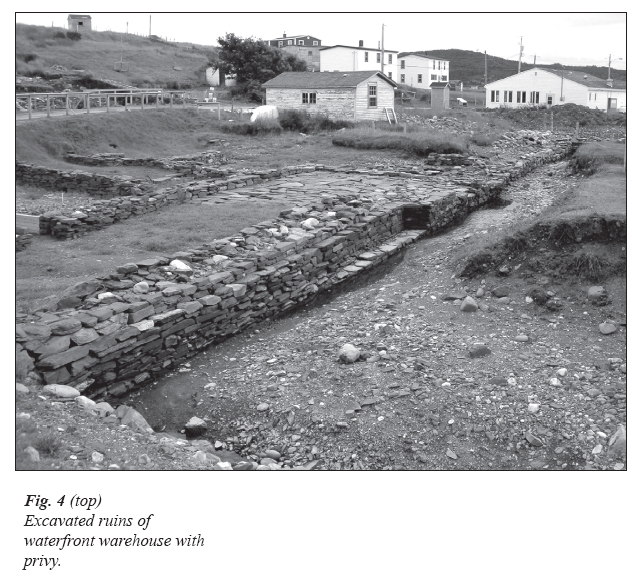
Display large image of Figure 4

Display large image of Figure 5
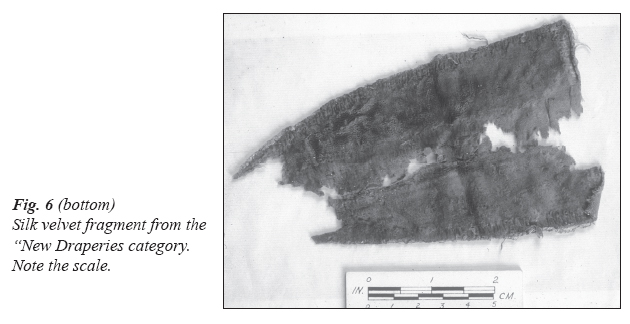
Display large image of Figure 6
6 Some of the textile remains found in the privy deposit are described here. The fragments were divided into two groups; those found in the privy and those found outside of it. Fragments include silk velvet, silk damask, silk satin and a variety of wool from the higher quality “New Draperies”3 category (Fig. 6). Table 1 presents the distribution of textile finds to 2006.
Analysis
7 All privy fragments were analyzed for fibre identification, thread count, type of weave and evidence of construction. In addition fifty-nine textile fragments were examined for fibre condition using a scanning electron microscope (SEM). The same samples were also analyzed for dyestuffs. Those samples testing positive for colouring agents are presented in Table 4.
Fig. 7 A twill woven worsted wool excavated from Event 111.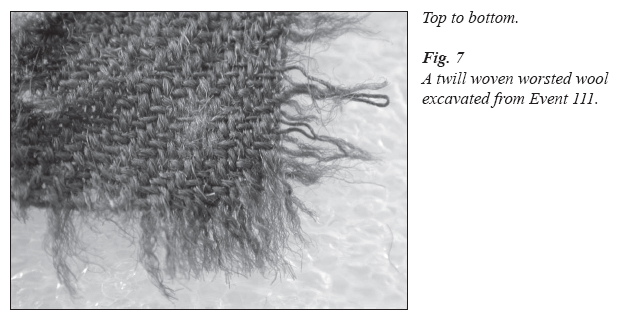
Display large image of Figure 7
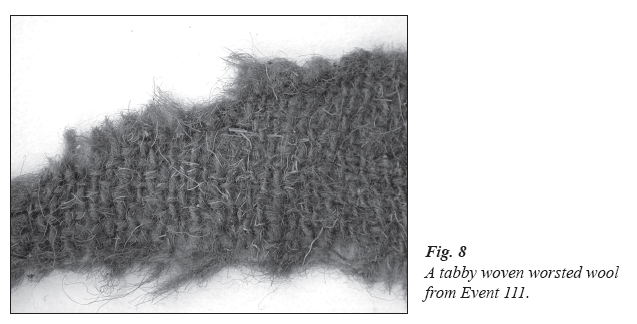
Display large image of Figure 8

Display large image of Figure 9

Display large image of Figure 10
8 Documentation and assessment of fibre condition was performed using the SEM at 500x and 1,100x magnification at the facilities at MUN. Dye analysis was performed at the Canadian Conservation Institute (CCI) in Ottawa, using high-performance liquid chromatography (HPLC), Fourier transform infrared spectroscopy (FTIR) and scanning electron microscope-energy dispersive x-ray (SEM-EDX).
Sampling for Analysis
9 For the purpose of dye analysis fifty-nine samples were selected, of which thirty-eight were wool and twenty-one were silk. For this sampling, selection was based on the likelihood of the fibres having been dyed. The dyestuffs were thought to be associated with fibres representing high fashion; the New Draperies, trim fragments and fine threads were considered likely candidates as high-fashion textiles. Fewer samples of “Old Draperies” were selected because as a lower quality textile they were not thought to represent high fashion. Some thirteen fragments of the Old Draperies and one knit yarn fragment were tested for comparison. The fifty-nine samples selected for dye analysis also underwent SEM analysis. This was more for convenience since the fibre selected for analysis could be divided into an SEM sample and a sample for dyestuffs analysis.
10 Thread counts were based on a one-by-onecentimetre square measure and were calculated for both warp and weft threads. The twist of the fibre produced during spinning is described as either S (counter-clockwise) or Z (clock-wise) twist.
11 The types of cloth materials available in the 17th-century include twill, tabby and satin weaves (Figs. 7 to 9). In the process of weaving, warp—or lengthways threads—are attached to a loom, while weft threads are repeatedly fed back and forth across the warp threads forming a selvage edge at either side of the fabric. A tabby weave is described as having one weft thread moving over and under one warp thread. For a twill-woven fabric, every weft thread crosses atop two or more warp threads and under one or more warp threads. This arrangement forms a diagonal stripe in the fabric. A satin weave has floater threads. The warp threads and weft threads cross each other at points that do not touch (Boersma 2007: 13). Fabric representing two other weaving techniques was also found in the privy. These include velvet and damask woven fabrics. Both weaving types are variations on the three described above. Velvet is a tabby weave in which the warp threads are raised in a loop. A damask pattern (Fig. 10) is created by a contrast of binding systems, the most common being satin (14).
12 Textiles of the Early Modern Period (New Draperies) are distinguished from those of the Medieval Period (Old Draperies) by their thread count and yarn thickness (Crowfoot et al. 1992: 26-44). The Old Draperies were woven with thicker threads. These threads were spun from short hairs, which required that they be numerous in order to provide strength in the thread. Thus, the thread counts for the woven fabric were low and an open weave was produced. The Old Draperies were commonly fulled—a process whereby the open weave structure was closed to tightened it so that the fabric would be warmer and water resistant.
Fig. 11 (left) A tablet woven trim from Event 116.
Display large image of Figure 11

Display large image of Figure 12
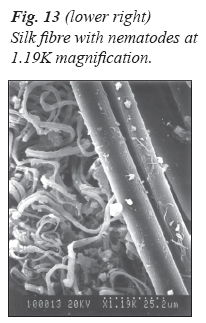
Display large image of Figure 13
13 By the 1600s, longer strands of wool were selected for spinning which allowed for a stronger, finer thread. These threads allowed a higher thread count in woven cloth and therefore a lighter cloth. For this research a thread count of fifteen threads or greater, per centimetre in either the warp or the weft was considered to indicate a New Drapery. This change in fabric manufacture provided a greater draping of costume and manipulation in its construction. The twist of the fibre also changed with the introduction of these New Draperies. According to Pritchard (2003) a Z-spun worsted yarn is one characteristic of the New Draperies. The change in the twist of the fibre, the fineness of fibre and a higher thread count of the fabric collectively define the New Draperies of the Early Modern Period.
Results
14 The distribution of textile finds excavated from the privy is presented in Table 1. The distribution of textile finds within the privy by weave is presented in Tables 2 and 3. Of the identifiable woven fabrics, 210 are wool and 18 are silk. Of these 228, 62 are classed as New Draperies based on thread count. Both the New Draperies and Old Draperies that tested positive for dyestuffs are presented in Table 4. The results of an analysis of fibre spin for woven wool are as follows: 66 had an S/S spin, 60 a Z/Z spin and 21 a S/Z or mixed spin; these are presented in Table 5. Silk fibres that had no visible spin are not included in this table. Overall there is a higher percentage of tabby-woven cloth with 109 positive identifications, while only 38 were identified as twill-woven. Of the 42 wool yarns, only 22 exhibited spin, 12 with an S-spin and 10 with a Z-spin. The results of the weave analysis indicate that the collection consists of worsted wool, worsted satin, knitted wool, silk damask, silk taffeta and satin, silk velvet and tablet-woven silk trim (Fig. 11). SEM analysis of wool fibres (Fig. 12) reveals a state of good preservation as indicated by complete bracts or scales. The smooth surface of the silk fibres (Fig. 13) signifies good condition as well.
15 The fragments in Table 4 are the fifty-nine tested that showed positive results for dye compounds. A compound indicative of tannins and ellagic acid was identified in all samples (Mathias et al. 2004: 34-35). Dyestuffs were conclusively identified in all samples: fourteen had compounds indicative of red dyes, (i.e., the anthraquinones carminic acid, alizarin and purpurin); four had hydroxyflavone luteolin, indicative of a yellow dye; one contained an unidentified coloured compound (Mathias et al. 2004: 26-41).
16 Analytical results for mordants indicate that they may have been used; however, their possible presence could represent contamination from the mineral-rich soils (Mathias 1998: 377; Mathias et al. 2004: 26-41). Using SEM/XES, inorganic components identified in most of the samples included: aluminum, magnesium, silicon, phosphorus, calcium, iron and, occasionally, sodium, potassium, chromium and titanium.
Evidence of Construction
17 Fifty textile fragments show evidence of garment construction. Fragments identified include: collars, collar facings, a doublet front, a doublet wing, doublet tabs, breeches waistband, breeches canion, garter fragments and petticoat fragments. A doublet front 78130a made of wool with silk thread-covered buttonholes is shown in figure 14.
18 The buttonhole stitching is rough, but the use of silk thread would have given a fashionable appearance to the entire piece. This garment was constructed using a felted twill weave. Samples of woven cloth preserved in a double-layer construction likely represent lined garments.
19 Dyestuffs of madder were identified on a collar fragment 101202, canion 109020 and doublet front 112648; cochineal was identified on silk trim, a mixture of cochineal and madder was identified on petticoat silk damask 124974, and silk velvet 101147; weld was identified on a doublet front section 78130a and a fine wool skirt fragment 67517. Tannin was identified on all fragments showing evidence of construction.
Discussion
20 The technical examination of the textile fragments from Ferryland (excluding trim, braid, threads and knitted fragments), including thread count and the identification of weave pattern, reveal a variety of fancy silks including damasks, satins and velvets, as well as finely-woven wools representing the New Draperies.
21 The bulk of the textile collection at Ferryland was excavated from a 17th-century privy. This feature offered both a wet environment, typical of a waterfront locale, and an anaerobic environment, produced by the matrix material of the privy. These environmental parameters have been identified as best for the preservation of archaeological textiles (Crowfoot et al. 1992: 5). Textiles found in the privy represent either tailor’s scraps or cloth pieces reused for the purpose of hygiene. Fragments from the privy are considered to represent some aspect of the daily activities of Ferryland’s colonists during the 1600s. Forty-two samples identified as yarns may represent coloured worsteds used for working curtains. These may also have been used for crewel work on upholstery fabrics, which was popular during the Restoration (Jones 1974).
22 Faunal remains excavated from Events 111 and 116 suggest the privy was used during the spring. Foetal and neonatal piglets found in Events 111 and 116 also suggest usage during the spring. Analysis of faunal remains also indicates the presence of crab, lobster, cod, mackerel and duck. Cod bones were found in the greatest quantity (Hodgetts 2006). Textile remains found in Events 111 and 116 could represent clothing used either during the spring, or discarded winter clothing reused for sanitary purposes.
23 Thread count was a distinguishing factor for newer fabrics produced in the Early Modern Period (Pritchard 2003: 228). Variations in thread count in these textile fragments provide evidence for the presence of both Old and New Draperies. Textiles found in the privy tend to be stratified with Old Draperies showing up prior to the mid-1600s as “clouts” and New Draperies deposited post-1650. High-fashion silks coincide with the early occupation of Ferryland at the time of Calvert’s presence. Events 116 and 111 date from the 1630s to 1650s. Most of the privy textiles were excavated from these two Events. Generally the Old Draperies represent clouts cut for use in the privy while silks may represent tailor’s scraps.
Fig. 14 Doublet fragment showing buttonhole stitching from Event 111.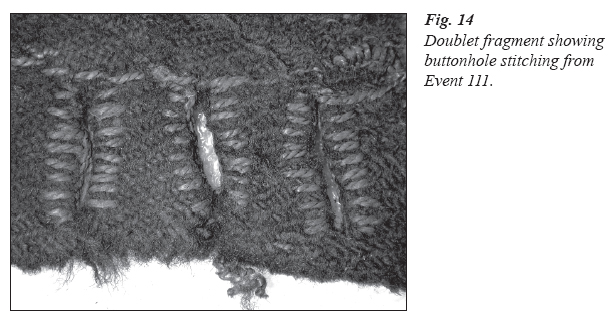
Display large image of Figure 14
24 Results of my testing reveal that most wools should be considered worsted. Taking their name from the type of yarn used, the term worsted appears in written records early in the 14th century (Kerridge 1985: 9). Most of the New Draperies found in the Ferryland privy would be considered worsted wools because of their long fibres and the identified combination of wool and silk.
25 Worsted satins represent one of the earliest New Draperies found in English deposits (Pritchard 2003). Samples of worsted satins from archaeological deposits in England date from the early 1500s to the 1600s (Pritchard 2003: 224; Walton 1981: 194-96). Characteristics of these fabrics, most of which were produced in Norwich, include being woven of a single, Z-spun worsted yarn, with selvages that show the fabrics were weft-faced sateens. Norwich merchants brought weavers from the Netherlands in the 16th century to teach local weavers satin and satin reverse production (Kerridge 1985: 46).
26 Thirsk (1973: 53) has reported that silk stockings were introduced to the gentry during the 16th century by the courts of both Henry VIII and Elizabeth I. She notes that stockings were imported from Spain until English-made silk stockings became more common in the late 1500s—around the time that worsted stockings were introduced to the luxury market. It wasn’t long before cheaper wool stockings flooded the English market, as even those who were not of the gentry wanted the comfort of knitted stockings. While Thirsk (1998: 259) suggests the overseas market for stockings also grew, the economic influence of the New Draperies during the 17th century remains a topic of debate among economic historians. Some scholars feel these new commodities changed overall textile production, while others disagree (Kerridge 1985: vii).
27 Early examples of some of the knitted tubular stockings from the collection at the Museum of London have ribbing at the heel. Knitted stockings are recorded as being produced using Z-spun worsted yarn in single ply, double ply, two-ply, or triple-ply (Farrell 1992: 9). There are eleven fragments of knitted wool in the Ferryland collection. Although samples were matted in the burial environment, three fragments are constructed of a two-ply wool with a Z-spin and match examples from the Museum of London’s collection.
28 A decline in the worsted industry of Norfolk was the main impetus for the introduction and production of new fabrics in England. The New Draperies can be viewed as a successful attempt at the commercialization of a peasant handicraft (Thirsk 1973: 52). Traditional worsteds were rock-spun using a distaff and drop spindle in a single ply (Pritchard 2003: 223). Patterned worsteds from the late-16th century onward were manufactured using plied yarn (ibid.). These New Draperies often had a “shot” appearance, or a changeable colour produced by combining different threads (ibid.).
29 Dye components identified on the New Draperies are luteolin, alizarin, purpurin and carminic acid. The Old Drapery samples tested positive for alizarin and purpurin. Ellagic acid was identified on twenty-three of fifty-nine samples tested. All samples with an identified dye compound tested positive for ellagic acid. The presence of ellagic acid on such a large number of samples suggests contamination by the burial environment, although it could also have been added as a mordant to enhance colour (Mathias et al. 2004: 26-41). Red dye from the costly cochineal insect was identified on only silk fragments. Yellow dyestuff was found on woven wool fragments with higher thread counts, or those described as New Draperies. The less expensive red dyestuff madder was found associated with samples of the Old Draperies.
30 Results show that fibres identified with a dyestuff were well preserved. It is possible this could be the result of dyes, such as luteolin or weld, acting as antioxidants. An examination of fibres under magnification show that, based on good morphological preservation, two-thirds of the collection was in a good to very good condition.
31 Textile remains that resemble garments are few, given that most of the privy collection were textiles that served as toilet “paper” and were cut from other garments, leaving only a hint of their former function. There are some examples of construction, such as fragment 78130a, a doublet front with button holes trimmed with silk threads. Samples of silk damask 124974 and 127294, were possibly once part of a petticoat and identify high fashion dress at Ferryland.
32 Fragments of trim and long narrow off-cuts of fabric found in the privy could be the result of tailoring activities especially since records indicate that a tailor, William Sharpus, was a resident of Ferryland in 1622.4 Egan (1995: 110) suggests that lead bale-seals excavated at Ferryland provide evidence of bolts of cloth being shipped to the site, all suggesting the possibility that Sharpus was making outwear garments on site for the colonists. The off-cuts found in the privy may have been disposed of there to ensure they not be recycled by others at Ferryland. The dominant types of textile found in the privy, in terms of cut, were square fragments or clouts, some folded and containing raspberry seeds. It is assumed that the cloth was cut into 10 by 10 centimetres squares to provide a means to clean oneself after using the toilet and these square fragments of cloth represent reused toilet paper.
33 Although it is assumed that any cloth imported into Ferryland would have arrived pre-dyed, there is archival evidence that George Calvert, while Secretary of State for James I, was charged with the mission of bringing the cultivation of madder to England from the Netherlands (Chenciner 2000: 60). Under Calvert, the plan for the colony at Ferryland, was that it be a plantation (in the sense of a colony) run as a co-operative venture in which all would benefit and where a concerted effort to achieve self-sufficiency was the objective (Pope 1996: 4). It is therefore possible that madder was grown in Ferryland and that the presence of some of the dyestuffs identified may be a result of the first attempts to develop a textile-dyeing industry in the New World.
Conclusion
34 The information presented here provides a description of the textile remains excavated from the only privy identified to date, from 17th-century Ferryland. Many of the recovered textile fragments were folded and contained seed deposits and human parasites, indicating their use as toilet paper or clouts. Clouts were primarily made of wool while the majority of off-cuts and trim—not used for hygiene purposes—were made of silk. Excavated yarns could represent coloured worsteds used for either working curtains or they could have been used for crewel work on upholstery fabrics.
35 The high concentration of textile fragments in the privy can be explained by their use for hygiene purposes. If these fragments had not been reused it is unlikely that any evidence of cloth would be preserved today. The high moisture content of the privy feature provided an environment for preservation. This is supported by SEM image analysis.
36 The privy matrix was layered with eight per cent of the textile collection found at the bottom of Event 170. Events 111 and 114 contained some twenty-two per cent of the privy collection and large amounts of faecal matter (Horn and Tuck 1996: 512-15). The next layer, Event 116, dates from the 1640s to the 1650s and contained forty-four per cent of the collection. The highest concentration of faecal matter was found here. The top two layers, Events 49 and 50, date just before the 1673 raid and contained twenty-six per cent of the collection.
37 Based on the definition of New Draperies used here, slightly more than one third of the textile finds excavated from the privy would be considered a New Drapery. Event 111, dating to the 1640s or 1650s, contained the highest percentage of wool Old Draperies. Events 111 and 116 yielded the largest concentration of woven textiles. This could mean that by this period the Old Draperies were used for hygiene purposes and that the privy was in frequent use at this time. Event 116, earlier than Event 111, which contained a wax seal—possibly Calvert’s—contained the highest concentration of silk New Draperies. The influence of the New Draperies during the 17th century remains a topic of controversy among economic historians. While some feel these new commodities changed the overall textile production, others do not. From the evidence presented here the New Draperies were clearly present early in the 17th century and were exported to the American colonies.
38 Dyestuffs identified on silk fragments include: cochineal, ellagic acid, alizarin and purpurin. Dyestuffs were detected on almost half of the woven wool items identified as New Draperies and include madder and weld. Only madder dyestuffs were identified on the Old Draperies. It is not surprising to find the expensive cochineal dyestuff used only on the finely-woven silk fragments.
39 The information obtained through this research is the result of the combined efforts of conservation scientists, a conservator and archaeologists. The collaborative results have allowed some preliminary conclusions to be drawn about early colonial material culture. One must conclude that most of the costume commodities that were available in Europe made it to Ferryland. Textiles present in the archaeological record indicate that the high status accrued to high fashion was followed by at least some of the people living in Ferryland during the 17th century.
Table 1 Frequency of Textiles by Material
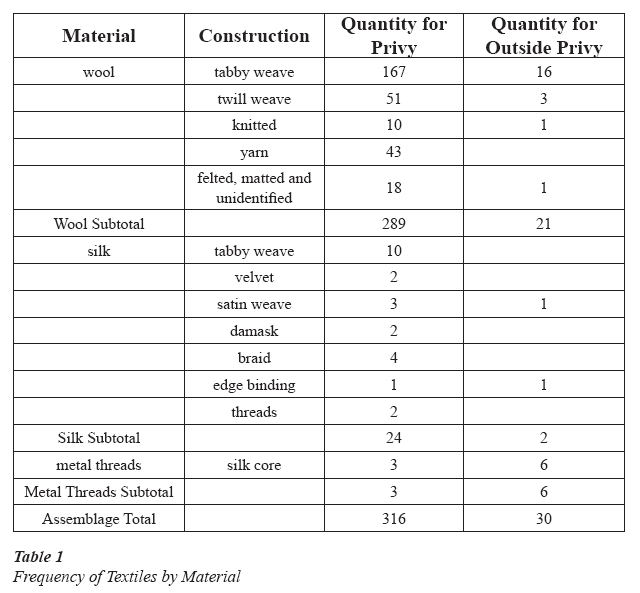
Display large image of Table 1
Table 2 Privy Stratigraphy and Textile Finds

Display large image of Table 2
Table 3 Textiles by Event

Display large image of Table 3
Table 4 Dyestuffs Present in Privy Textiles
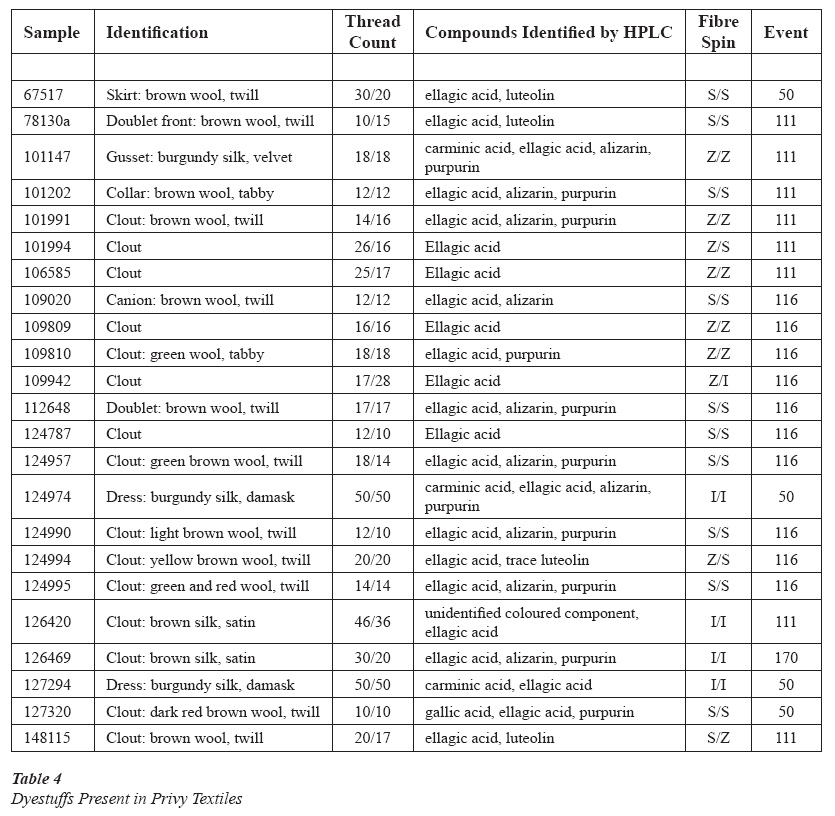
Display large image of Table 4
Table 5 Fibre Spin for Woven Wool Fragments
References
Arnold, Janet. 1985. Patterns of Fashion: The Cut and Construction of Clothes for Men and Women c. 1560-1620. London: Macmillan Publishers Ltd.
Boersma, Foekje. 2007. Unravelling Textiles: Handbook for the Preservation of Textile Collections. London: Archetype Publications.
Brooks, Mary M. 2004. English Embroideries. London: Jonathan Horne Publications.
Chenciner, Robert. 2000. Madder Red, A History of Luxury and Trade. England: Curzon Press.
Crowfoot, Elisabeth, Frances Pritchard and Kay Staniland. 1992. Textiles and Clothing, c. 1150-1450. London: HMSO.
Deetz, James. 1977. In Small Things Forgotten: The Archaeology of Early American Life. New York: Doubleday.
Egan, Geoff. 1995. Lead Cloth Seals and Related Items in the British Museum. Occasional Paper 93. London: The British Museum.
Farrell, Jeremy. 1992. Socks and Stockings. London: Batsford.
Gaulton, Barry and James A. Tuck. 2003. The Archaeology of Ferryland, Newfoundland Until 1696. Avalon Chronicles 8: 189-224.
Hodgetts, Lisa M. 2006. Feast or Famine? Seventeenth-Century English Colonial Diet at Ferryland, Newfoundland. Historical Archaeology 40 (4): 125-38.
Horn, Patrick and James A. Tuck. 1996. Archaeoparasitology at Ferryland, Newfoundland. Journal of Parasitology 82 (3): 512-15.
Jones, Mary Eirwen. 1974. English Crewel Designs. London: Macdonald.
Kerridge, Eric. 1985. Textile Manufactures in Early Modern England. Manchester: Manchester University Press.
Mathias, Cathy. 1998. Examination of Interactions Between Ferrous Metals and the Archaeological Burial Environment at a Seventeenth-Century Plantation Site. MA thesis, Memorial University of Newfoundland.
Mathias, Cathy, Elizabeth Moffatt and Alison Murray. 2004. Technical Analysis of Textile Remains from a 17th-Century English Plantation at Ferryland, Newfoundland and Labrador, Canada. Journal of the Canadian Association for Conservation 29:26-41.
Pope, Peter E. 1996. Six Letters from the Early Colony of Avalon. Avalon Chronicles 1: 1-20.
Pope, Peter E. 1998. Baltimore vs. Kirke: Newfoundland Evidence in an Interregnum Lawsuit. Avalon Chronicles 3: 63-99.
Pope, Peter E. 2004. Fish into Wine: The Newfoundland Plantation in the Seventeenth Century. Chapel Hill, NC: University of North Carolina Press.
Pritchard, Francis. 2003. The New Draperies: Examples from Archaeological Deposits in England. In: Textilien aus Archäologie und Geschicte: Festschrift für Klaus Tidow, eds. J. Banck, L. Bender Jorgensen and A. Rast-Eicher, 222-32. Neumünster: Wachholtz Verlag.
Styles, John. 2000. Product Innovation in Early Modern London. Past and Present 168 (1): 124-69.
Thirsk, Joan. 1973. The Fantastic Folly of Fashion: The English Stocking Knitting Industry 1500-1700. In: Textile History and Economic History: Essays in Honour of Julia de Lacy Mann, eds. N. B. Harte and K. G. Ponting, 50-73. Manchester: Manchester University Press.
———. 1998. Luxury Trades and Consumerism. In Luxury Trades and Consumerism in Ancien Regime Paris: Studies in the History of the Skilled Workforce, eds. Robert Fox and Anthony Turner, 257-62. Great Britain: Ashgate Alder Sort.
Walton, P. 1981. An Excavation in the Castle Ditch, Newcastle upon Tyne: The Textiles. Archaeologia Aeliana 9:194-96.
Wheale, Nigel. 1991. Writing and Society: Literacy, Print and Politics in Britain 1590-1660. London: Routledge.
Notes
